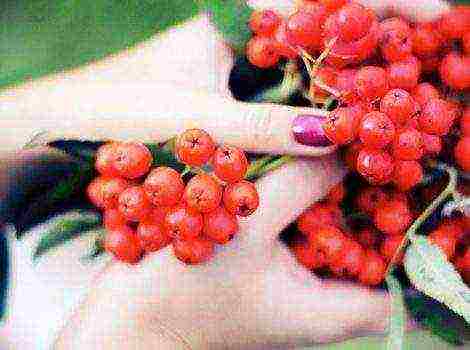Content
How and what to feed lemon at home
Growing a lemon tree at home is not difficult. A beautiful exotic plant will not only decorate the interior, it will saturate the air in the room with phytoncides and give a fragrant fruit rich in vitamins for tea. But in order for the lemon to develop and bear fruit, it must be fed.
Why does lemon need fertilizing
At home, hybrid varieties are usually grown, specially created by breeders for growth and development on a windowsill or in a warm, well-lit room. The root system of a medium-sized tree is about 40 times smaller than that of greenhouse lemons. Therefore, for normal growth and fruiting, the lemon must receive nutrients from the outside, and not periodically, but regularly.
Lemon branches can simultaneously have flowers, ovaries, unripe and ripe fruits. That is, the root system must provide the tree with a huge amount of nutrients. Otherwise, the leaves turn yellow and fall off, the tops of the shoots dry up, the fruits become small, rough, often fall off in an immature state.
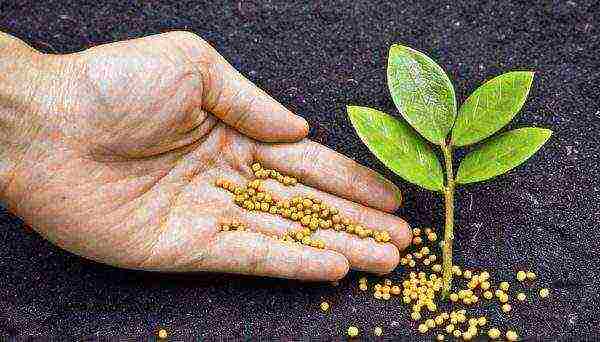
How to fertilize lemon at home
Since the root of the lemon is not very large, it should not be overloaded with fertilizers. Lemon loves frequent, but not plentiful watering and feeding. INDuring spring-summer fruiting and active growth, approximately from early March to mid-autumn, plants must be fertilized once every 2 weeks, and the rest of the time - once a month. More precisely, the frequency and amount of feeding must be decided independently, depending on the state of the plant, its size and the number of fruits on it.
What fertilizers are needed for citrus trees
How to determine exactly whether lemon needs nutrition at the present time, and what substances does it lack in order for it to grow healthy and bring good harvests? It turns out that this is not difficult to do - you need to carefully monitor the leaves, lateral shoots and fruits. If the leaves turn yellow, warp, lose their shine and gloss, the tops of the shoots dry up, flowers and unripe fruits fall off, it means that the plant is starving.
The most basic substances that a lemon needs are phosphorus, nitrogen, potassium. In addition to them, iron, sulfur, copper, magnesium, zinc and boron should be added occasionally. Nitrogen should be twice as much as phosphorus and potassium.
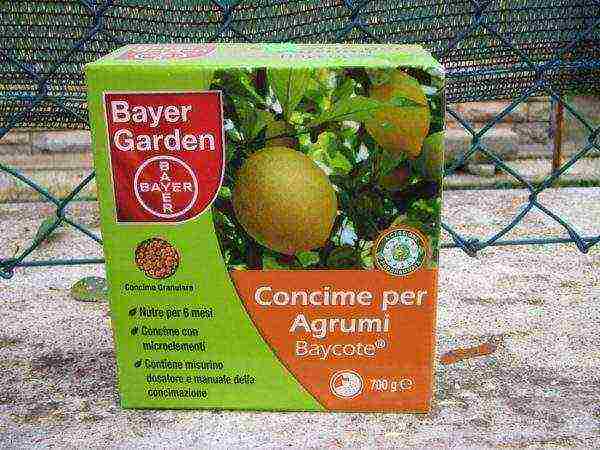
How does the deficiency of each of the substances affect lemon?
Nitrogen - contributes to the full growth and development of the plant, respectively, its lack leads to growth retardation, depression. Yellow spots appear on old leaves, and then they turn completely yellow, young leaves become pale green in color, the fruits are very small, the yield is low.
Phosphorus. Its deficiency leads to metabolic disorders, the leaves become dull, lose their gloss, the fruits are rough, very dense, and ugly in shape.
Potassium - also one of the most important trace elements; lack of potassium salts leads to an abnormal increase in leaf size and the appearance of a very pronounced folding.The plant greatly inhibits growth, during flowering leaves fall off, as there is not enough nutrition, the yield is low, the fruits are small, the peel on them is very thin. With high soil moisture, sticky dew appears on the leaves.
Iron... The lack of this element leads to the development of chlorosis - the leaves gradually turn pale, dark streaks appear on them, the fruits also turn pale, their growth slows down, and fall off in an immature state. The upper parts of the shoots do not receive nutrition at all and dry up.
Sulfur, manganese, boron, calcium, copper - the absence of these microelements affects the condition of young leaves and shoots, yield and fruit quality. Lack of calcium - the leaves curl up and fall down, the tops of young shoots are discolored.
Strongly pronounced vein pattern on pale leaves - lack of manganese. Long-term lack of copper in the diet leads to constant wilting of the upper part of the crown. Due to the lack of boron, the leaves begin to curl, turn pale, watery spots appear on some, the veins crack and dry out. Dark spots and resin clumps appear on lemon fruits.
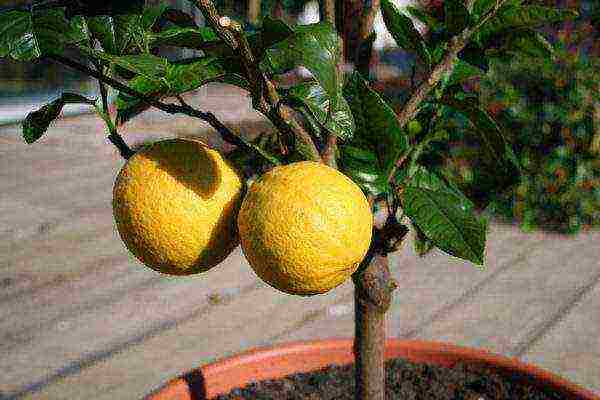
Sources of nutrients during the period of active growth and fruiting
Lemon is an evergreen tree that grows throughout its life, which is why the plant requires constant regular feeding. Indoor lemon usually reacts very well to all types of mineral and organic fertilizers, but they should not be applied at the same time in any case, as this can harm the plant more than help.
As already mentioned, the active period of development and growth of the lemon tree falls on March - September. At this time, the branches have everything - from flowers to ripe fruits. Therefore, the most relevant during this period will be complex fertilizers. It is better for novice gardeners to buy ready-made dosed complex fertilizing and follow the instructions for applying them to the soil exactly.
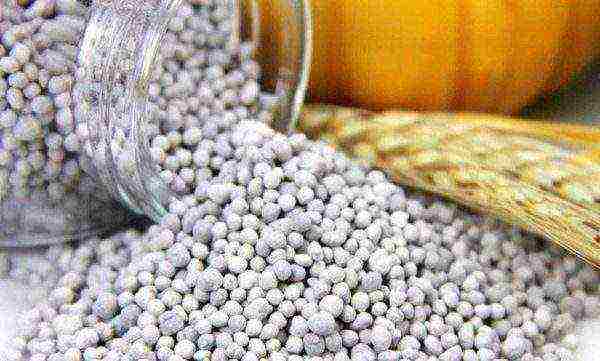
In addition, at home, you can very easily fertilize lemon with available tools:
- nitrogen sources - silt or crushed quinoa leaves; they replace the topsoil in pots with lemon; if you prefer nitrate, then you need to water the plant with a 0.5% solution;
- phosphorus - an excellent source is carpentry (bone glue); Mix 2 g of glue with 1 liter of water and boil for 30 minutes, cool, pour over lemon, after half an hour, loosen the soil well; it is good to add superphosphate to the slurry during fermentation (50g per 10l) and then feed with this solution;
- calcium + phosphorus + potassium - ordinary wood ash serves as a full-fledged fertilizer for citrus fruits, the norm is 1 tbsp. spoon for 1 liter of water;
- tea leaves and coffee grounds contain many useful trace elements - magnesium, potassium, calcium, phosphorus, manganese, copper, iron; of course, their number is not enough to properly nourish the tree, but as an auxiliary feeding it is quite suitable, you just need to be careful so that black midges do not start;
- not a strong solution of potassium permanganate at the same time nourishes the plant and disinfects the soil, only they need to be watered at night, since in sunlight the solution quickly turns pale and loses its strength;
- organic fertilizers - manure, chicken or pigeon droppings, which must be diluted with water, fermented for 10 days, and then add water, bringing to a low concentration, and water the plants; it is necessary to take into account that fresh manure is healthier, since it is enriched with nitrogen as a result of fermentation.
Of course, you can buy specially balanced complex fertilizers for citrus crops - it will be easier for beginners to monitor the health of pets.
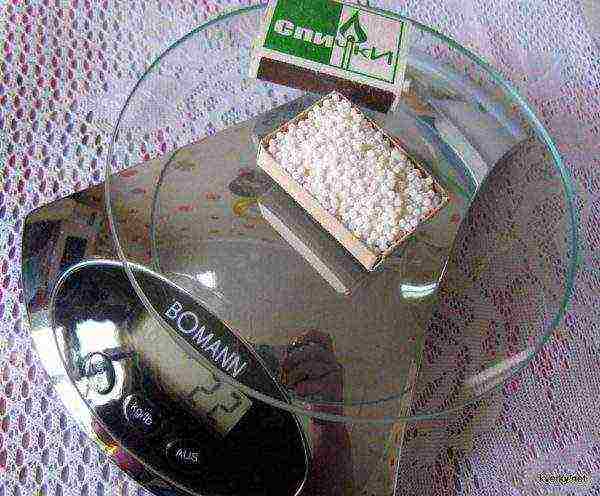
Optimal fertilization pattern
So, if you want to grow a healthy tree and get stable yields, you will have to take care of lemon all year round, observing the necessary frequency of feeding:
- March - once every 10 days, water with slurry (100g per 1l) + 5g superphosphate per 1l of water;
- April - 3 dressings - superphosphate (5g x 1l), potassium sulfate (3g), a complex of trace elements (1g x 1l);
- May - urea (1.5 g), superphosphate (5 g), complex fertilizer (1 g);
- June - urea (1.5 g), potassium sulfate (3 g), superphosphate (5 g);
- July - chicken or pigeon droppings (slurry 40g of dry matter per 1 liter of water), boric acid (0.2g x1l - foliar feeding), slurry;
- August - potassium permanganate (0.2% solution), a complex of trace elements;
- September - February - once a month for 1 g of complex fertilizers with microelements.
| When | How | How many gr. for 1 lire of water |
| February | Horse manure infusion | 100 |
| Superphosphate | 5 | |
| Horse manure infusion | 100 | |
| March | Ready-made mineral complex with trace elements | 1 (or according to the instructions) |
| Horse manure infusion | 100 | |
| April | Ready-made mineral complex with trace elements | 1 (or according to the instructions) |
| Urea | 1,5 | |
| Superphosphate | 5 | |
| Ready-made mineral complex with trace elements | 1 (or according to the instructions) | |
| May | Urea | 1,5 |
| Potassium sulphate | 3 | |
| Superphosphate | 5 | |
| June | Horse manure infusion | 100 |
| Ready-made mineral complex with trace elements | 1 (or according to the instructions) | |
| Urea | 1,5 | |
| July | Horse manure infusion | 100 |
| Ready-made mineral complex with trace elements | 1 (or according to the instructions) | |
| Urea | 1,5 | |
| August | Potassium permanganate | 0,2 |
| Ready-made mineral complex with trace elements | 1 (or according to the instructions) | |
| September | Potassium sulphate | 3 |
| Superphosphate | 5 | |
| October | Ready-made mineral complex with trace elements - foliar feeding | 0.5 (or according to the instructions) |
| November | Ready-made mineral complex with trace elements | 1 (or according to the instructions) |
| December | Ready-made mineral complex with trace elements - foliar feeding | 0.5 (or according to the instructions) |
| January | Ready-made mineral complex with trace elements | 1 (or according to the instructions) |
It is up to you to choose fertilizers or improvised means, the main thing is to feed the lemon on time, monitor its health, do not overdo it with "nutrients", and your pet will respond with a harvest of fruits rich in vitamins.

